The Abbey of Saint Gall is located in St. Gallen, the capital city of the canton of St. Gallen in the northeastern part of Switzerland. The Abbey of Saint Gall is considered a good example of a Carolingian monastery. From the founding in the 8th century until its dissolution in 1805, the Abbey of Saint Gall was one of the most important monasteries in Europe. The history of this abbey begins in 612 AD, when the Irish monk Gallus built an oratory. More than a century later the oratory was replaced by an impressive church. Later, the Benedictine Order of Saint Gall was founded. The Abbey of Saint Gall was rebuilt in the Baroque style in the 18th cenrury. The cathedral and library are the highlights of this notable monastery complex. The architecture of the library is in the Baroque style, but it is decorated in the Rococo style. The Abbey Library of Saint Gall is one of the richest and oldest libraries in the world. The library contains 130,000 books, including precious manuscripts and also the earliest-known architectural plan drawn on parchment, the famous Plan of Saint Gall. The Plan of Saint Gall was drawn in a scriptorium on the Monastic Island of Reichenau around the year 820. It is the only architectural plan in the world from the Carolingian period to have been preserved in its original condition. The Plan of Saint Gall does not correspondent to any place that was actually built, but it can be regarded as the plan of the ideal monastic architecture. Also one of the three complete versions of the Nibelungenlied are saved at the Abbey Library of Saint Gall. The Abbey of Saint Gall includes the Bishop's Palace, which is still occupied by the Bishop of St. Gallen today. The Abbey of Saint Gall gained the status as a UNESCO World Heritage in 1983.
www.werelderfgoedfotos.nl © Copyright World Heritage Photos
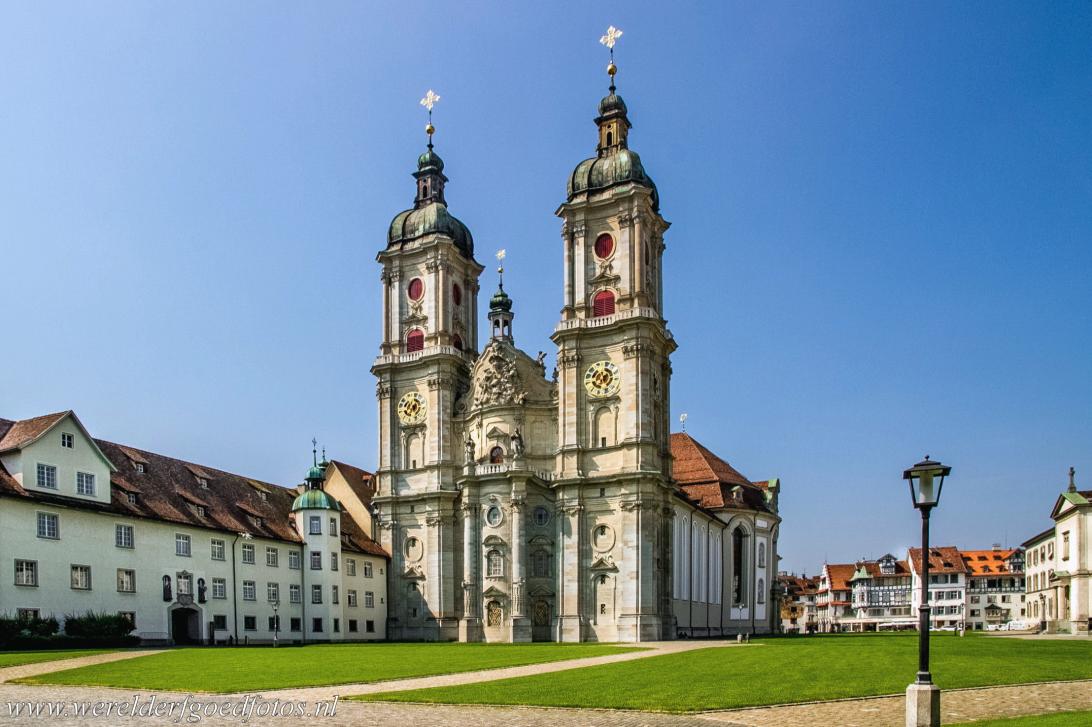
Abbey of Saint Gall: The history of the Abbey of Saint Gall begins in the year 612 AD, when the wandering Irish monk Gallus built small oratory. Later, this oratory was replaced by an imposing church. The Abbey of Saint Gall was considered a good example of a Carolingian monastery. The two twin towers of the abbey dominate the skyline of the city of Sankt Gallen. The towers house a set of nine bells, they are the most complete set of historic church bells in Switzerland.

Abbey of Saint Gall: The history of the Abbey of Saint Gall begins in the year 612 AD, when the wandering Irish monk Gallus built small oratory. Later, this oratory was replaced by an imposing church. The Abbey of Saint Gall was considered a good example of a Carolingian monastery. The two twin towers of the abbey dominate the skyline of the city of Sankt Gallen. The towers house a set of nine bells, they are the most complete set of historic church bells in Switzerland.
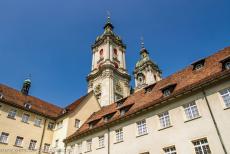
Abbey of Saint Gall: The towers of the abbey seen from the courtyard of the Bishop's Palace, the palace is still occupied by the Bishop of St. Gallen. The abbey was founded in 719, on the spot where the Irish monk Gallus built his hermitage and oratory in 612. In 747, the abbey became a Benedictine monastery, the first abbot was Saint Othmar, the founder of the abbey. The Abbey of Saint Gall grew into an important school of learning and has been a cultural centre for ages.

Abbey of Saint Gall: The abbey buildings are adorned with green weathered copper gargoyles. From its founding in the 8th century until its dissolution in 1805, the Abbey of Saint Gall was one of the most important monasteries in Europe. In the period 1755-1768, the original Carolingian church was rebuilt in the Baroque style. Little remains of the original Carolingian building. The Abbey of Saint Gall was declared a UNESCO World Heritage in 1983.
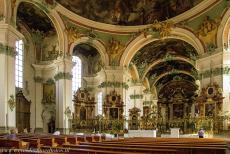
Abbey of Saint Gall: The Cathedral of Saint Gall is overwhelming decorated in the late Baroque style. The frescoes are almost entirely the work of the German artist Josef Wannemacher, he also painted the frescoes in the library of the abbey. The cathedral houses handbell, brought by the monk Gallus on his journey from Ireland. The bell is preserved on the right side of the altar. It is one of the three oldest surviving bells in Europe.
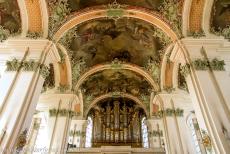
Abbey of Saint Gall: The main organ was built during the restoration of the abbey in the period 1961-1967. The abbey church was rebuilt in the Baroque style, only the foundations and some architectural elements remain from the original Carolingian church. The frescoes on the ceiling of the cathedral were painted by the German artist Josef Wannemacher in the 18th century. The Cathedral of Saint Gall is considered the most beautiful Baroque church in Switzerland.
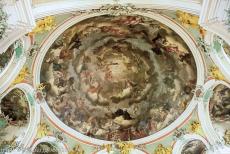
Abbey of Saint Gall: The impressive abbey complex, together with the cathedral and library, is a magnificent testimony to the Late Baroque flowering of the Abbey of Saint Gall. The cathedral is adorned with frescoes created by Josef Wannemacher in the period 1757-1766, the huge central cupola represent a vision of paradise: the Holy Trinity surrounded by apostles and saints, sitting upon concentric rings of clouds.
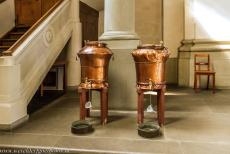
Abbey of Saint Gall: Two huge copper holy water fonts in the Cathedral of Saint Gall. The abbey is situated in the historic centre of Sankt Gallen, the capital city of the canton of Sankt Gallen in the northeastern region of Switzerland. The town grew up around the Abbey of Saint Gall. The abbey is an enormous Catholic religious complex, it includes also the Bishop's Palace, which is still occupied by the Bishop of St. Gallen today.
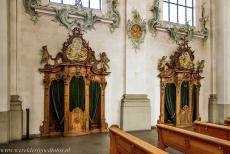
Abbey of Saint Gall: The carved walnut-wood confessional chairs in the cathedral. The Abbey Library of Saint Gall is one of the most important libraries in the world and nearly unrivaled in beauty. The architecture of the library is in the Baroque style, but it is decorated in the Rococo style. The library houses the Egyptian mummy Shep-en-Isis, or Schepenese, the daughter of a priest. She died in the 7th century BC at the age of around thirty. It is not permitted to take any photos inside the Abbey Library of Saint Gall.
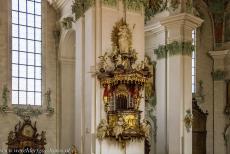
Abbey of Saint Gall: The richly decorated pulpit is a masterpiece of woodcarving, the pulpit was completed in 1766. The Baroque portal of the abbey library was created in 1781 by Franz Anton Dirr, the frescoes on the ceiling were made by Josef Wannemacher. The library contains 130,000 books, including precious and unique handwritten manuscripts. The archives contain a unique collection of early medieval documents, such as the earliest-known architectural plan drawn on parchment, the famous Plan of Saint Gall.

Abbey of Saint Gall: A part of the Plan of Saint Gall, the plan is an early medieval architectural drawing on parchment. The plan is the earliest-known architectural plan drawn on parchment, it was drawn on the Monastic Island of Reichenau around 820 AD. It is preserved in the Abbey Library of Saint Gall. The Plan of Saint Gall is considered a national treasure of Switzerland. The Plan of Saint Gall was never actually built.

Abbey of Saint Gall: The vaulted cellar of the abbey. The Lapidarium is situated in the cellars of the Abbey of Saint Gall, it houses a collection of medieval sculptures, a number of capitals from the Carolingian period (750-900) as well as objects dating from the Ottonian period (900-1050) and objects from the 15th until the 17th centuries. The cellar houses also another permanent exhibition: Gallus and his Abbey.
